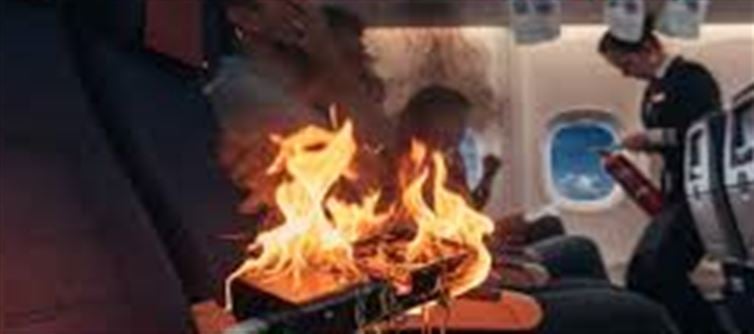
Power banks have become an essential travel companion, especially for passengers who want to charge their phones or gadgets on the go.
However, there has been a worrying rise in incidents of power banks catching fire or overheating during flights, prompting authorities and airlines to issue new safety advisories.
🧯 Recent Concerns and government Action
In recent years, several indian airlines and international carriers have reported smoke or fire incidents caused by malfunctioning or poor-quality power banks in cabin baggage.
The Directorate General of Civil Aviation (DGCA) and Bureau of Civil Aviation Security (BCAS) have been closely monitoring the issue, with possible plans to tighten regulations on the types and capacities of power banks allowed onboard.
Government and aviation safety experts warn that the lithium-ion batteries used in most power banks are highly energy-dense and can be volatile if damaged, overcharged, or exposed to heat — a serious safety hazard on aircraft.
🔋 The Science: Why Power Banks Catch Fire
Power banks use lithium-ion or lithium-polymer cells — the same technology found in mobile phones and laptops.
These batteries can store large amounts of energy in a compact space, but they are sensitive to temperature, pressure, and physical stress.
Here’s why they can ignite:
1. Thermal Runaway
o The most common cause of battery fires.
o When a battery cell overheats due to internal short-circuit or overcharging, it creates a chain reaction — generating heat faster than it can dissipate.
o This can cause smoke, swelling, explosion, or fire.
2. Poor Manufacturing Quality
o Cheap or counterfeit power banks often lack protective circuits that prevent overcharging, overheating, or voltage surges.
o Low-quality cells may leak or short-circuit more easily.
3. Physical Damage
o Dropping or crushing a power bank can rupture the internal separator between positive and negative electrodes, triggering a short circuit.
4. Exposure to Heat or Pressure
o In a closed aircraft cabin, temperature fluctuations or storage in overhead bins near vents can stress the battery.
o Storing power banks in checked-in luggage (where temperature and pressure vary) can be especially dangerous.
5. Using Uncertified Chargers or Cables
o Charging a power bank with incompatible or fake cables can cause current fluctuations, damaging internal components.
🧳 Why Power Banks Are Not Allowed in Checked-in Baggage
Most airlines strictly prohibit carrying power banks in checked luggage.
This is because if a fire starts in the cargo hold, it’s difficult for the crew to detect or extinguish it in time.
That’s why the International air Transport Association (IATA) and DGCA mandate that:
· Power banks must only be carried in cabin baggage.
· The device should be switched off and not used during the flight.
· Power banks above a certain capacity (usually 100 Wh) require airline approval.
· Those above 160 Wh are strictly prohibited on flights.
🧠 Safety Tips for air Travellers
To minimize the risk of fire or overheating during air travel, follow these precautions:
1. ✅ Use certified, branded power banks
o Choose BIS-certified (Bureau of indian Standards) or CE-certified models.
o Avoid cheap, no-name products that may not follow safety norms.
2. 🔌 Check battery capacity (Wh rating)
o Under 100 Wh: Allowed in hand luggage (no approval needed).
o 100–160 Wh: Airline approval required.
o Above 160 Wh: Not allowed on aircraft.
3. 👜 Carry in hand baggage only
o Keep your power bank in your carry-on bag.
o Never pack it in checked-in luggage.
4. ⚠️ Do not charge devices during flight
o Avoid using your power bank while the aircraft is in the air unless permitted by crew.
5. 🔥 Avoid overcharging and physical damage
o Do not leave your power bank charging overnight or under pillows.
o If it looks swollen, leaks, or heats up abnormally — dispose of it safely.
6. 🧊 Keep away from heat and direct sunlight
o Store in a cool, dry place.
o Never leave it inside a parked car or near heating vents.
7. 🧾 Buy from trusted sellers
o Always purchase from official brand stores or verified online platforms.
o Look for warranty and safety certifications.
🧮 How to Check Power bank Capacity (Watt-Hours or Wh)
If your power bank only lists mAh (milliamp-hours) and voltage (V), use this formula:
Wh=mAh×V1000\text{Wh} = \frac{mAh × V}{1000}Wh=1000mAh×V
Example:
If your power bank is 20,000 mAh and 3.7 V,
(20000×3.7)÷1000=74Wh(20000 × 3.7) ÷ 1000 = 74 Wh(20000×3.7)÷1000=74Wh
✅ Safe for flights (below 100 Wh).
✈️ Possible Upcoming Rules
As incidents rise, the government and DGCA are considering:
· Mandating only BIS-certified power banks on flights.
· Requiring clear labeling of watt-hour capacity on all power banks.
· Heavier penalties for carrying uncertified devices in checked baggage.
· Periodic inspections of electronic items at security checks.
💬 Conclusion
Power banks are incredibly useful, but they are also potential fire hazards if mishandled.
Most incidents occur due to poor-quality or damaged batteries and lack of awareness among travellers.
By using certified products, following airline safety rules, and handling devices responsibly, passengers can ensure both personal safety and in-flight security.
Disclaimer:
The views and opinions expressed in this article are those of the author and do not necessarily reflect the official policy or position of any agency, organization, employer, or company. All information provided is for general informational purposes only. While every effort has been made to ensure accuracy, we make no representations or warranties of any kind, express or implied, about the completeness, reliability, or suitability of the information contained herein. Readers are advised to verify facts and seek professional advice where necessary. Any reliance placed on such information is strictly at the reader’s own risk.




 click and follow Indiaherald WhatsApp channel
click and follow Indiaherald WhatsApp channel